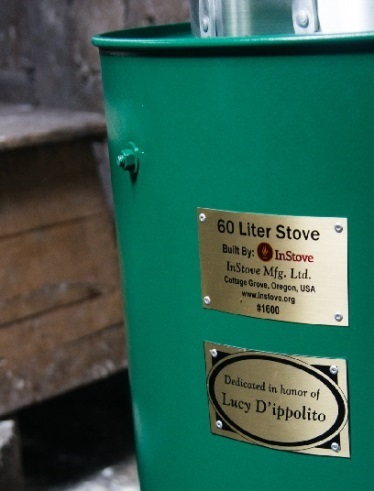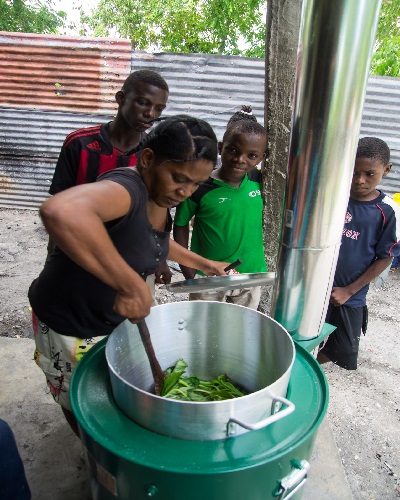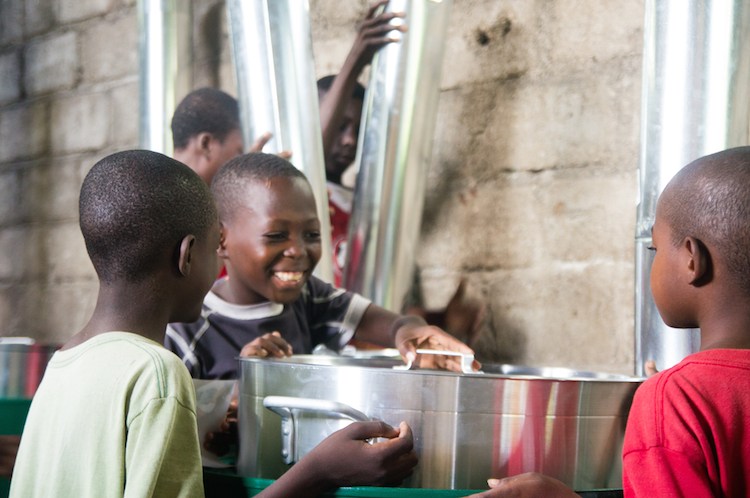When InStove first started out, their “green” stoves were written off as “patio furniture.”
Years later, these multi-purpose, biomass cook stoves are feeding thousands of children across Haiti while ensuring the safety of the cooks who prepare the meals.
The latest stove to arrive in Haiti is dedicated in the memory of my grandmother, Lucy, who passed away in June. She was a beautiful, warm-hearted woman who always made sure everyone was fed–and often took pans out of the oven with her bare hands (as we all gasped).

Many people gift InStoves in someone’s name as a way to honor their memory; individuals and organizations raise money to buy the stoves at cost, and donate them to developing countries overseas. Currently, they are being used in hospitals, clinics, schools, refugee camps, and orphanages.
The “Lucy Stove” recently landed at El Shaddai Ministries, an organization that feeds, houses, and educates 200 orphans in the Cambry, Sud region.
Before the InStoves arrived, cooks were preparing food over dirty, open charcoal burners, breathing fumes for hours each day while cooking hundreds of meals. Additionally, the unsustainable charcoal used for cooking was made from dwindling forest resources in Haiti, which has a 97% deforestation rate—it was costing the orphanage $400 each month.
Now, the kitchen can sustainably cook on sticks collected on the property and in the vicinity, feed thousands of kids and community members over its lifetime, and save them money on their energy bills.
And, just like grandma’s invulnerable hands, no one will ever be burned by it.
 InStove also sent an autoclave unit to the El Shaddai Ministries clinic—a health facility which previously had no way to safely sterilize medical equipment or waste.
InStove also sent an autoclave unit to the El Shaddai Ministries clinic—a health facility which previously had no way to safely sterilize medical equipment or waste.
The mere task of cooking food overseas is a larger problem than you’d think: nearly three billion people worldwide cook on inefficient, biomass fires, contributing just as much to global climate change as car tailpipes do.
InStove’s design reduces the amount of fuel needed by up to 90 percent, the equivalent to the carbon footprint of up to 2.7 American households.
And, because the stoves are all vented to outside the kitchen, the cooks can breathe easier.
“This is exciting,” said one of the cooks at El Shaddai. “Now I can wear my church clothes to work!”
The Lucy Stove itself was also made with love—InStove founder Fred Colgan, 71, and his co-founder, Damon Ogle, put the finishing touches on the stove together this past July. The two men hadn’t worked side-by-side on stoves since the first 50 were shipped out to Darfur six years ago.
CHECK Out: Pastor Turns Food Desert into Garden of Eden for the Poor
Ogle had recently finished treatment for throat cancer, but still decided to drive down to the factory facility in Oregon to help out.
In the beginning, when Colgan, then a 65-year-old retired carpenter, met Ogle, an engineer with a new stove design, they both shared a common vision to help some of the world’s poorest people.
“I asked him if he thought it was something we could take to the world and serve poor people with as a nonprofit,” Colgan told Good News Network. “I guess we were in the right place at the right time, just two stubborn old guys who wanted to make a difference.”
Colgan and Ogle immediately got to work hand-building prototypes of a stove that featured a combustion chamber made of stainless steel surrounded by lightweight insulation. At operating temperature, which can reach 1100 degrees Celsius, the stove literally “burns up the smoke,” and captures over half the energy generated by the fire.
Currently, there are InStoves located around the world, including 100 in North Darfur and 100 in South Darfur being used to feed 200,000 children. Colgan trained many of those cooks himself.
(WATCH the video below or visit InStove.org to learn more)




















